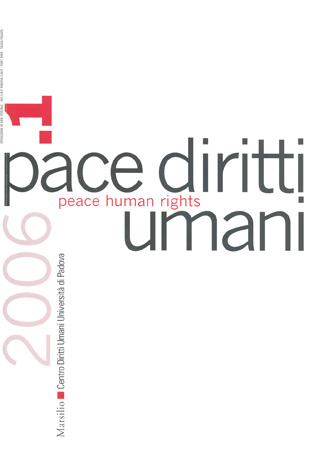Collections

10 anni di Tavola della Pace: la via Perugia-Assisi alla pace positiva
- Contained in
- Pace diritti umani - Peace Human Rights, 1/2006
- Pubblication type
- Articolo / Saggio
- Pages
- 109-124
- Language
- IT
10 Years of the Peace Table: The Perugia-Assisi Way to Positive Peace
Antonio Papisca
The celebration of the 10th birthday of the «Peace Table» (Tavola della Pace) took place in Assisi on 13 January 2006, at the Sacro Convento of St. Francis. The Peace Table is an original permanent network based in Perugia and involving more than 700 Civil Society entities (ONGs and social movements), and 657 Local Government Institutions (Municipalities, Provinces, Regions). The philosophy of the Peace Table can be summarised in the motto: «peace, human rights and democracy from the city up to the United Nations». The most significant initiatives that mark the identity of the Table are the «Peace March Perugia-Assisi» and the «Assembly of Peoples of the United Nations Organisation». Both are convened every two years and hundred thousands people participate in the events. The first session of the «Assembly of the UNO Peoples» took place in 1995 on the occasion of the 50th anniversary of the United Nations: it was one of the most impressive gatherings in the world. Since then the Peace Table strives, by denouncing and proposing, for strengthening and democratising the UN as a priority for the construction of a peaceful, just and democratic world order. So far, six sessions of the Assembly of the UN Peoples have been organised. In November 2004, an extraordinary international conference was held in Padua, with the co-operation of the Human Rights Centre of the University, gathering the representatives of more than 100 international NGOs and social movements under the label: «Reclaim our United Nations». The Assisi Meeting provided the opportunity to assess the past of the Peace Table and to elucidate its identity for further developments. There was unanimous agreement on aknowledging that the Table is, among other: a symbol of cultural-political identification for large portions of civil society, it facilitates and nurtures co-operation within an impressive variety of civil society organisations (lay as well religious), it disseminates and updates the culture «pace-human rightssocial and economic justice-international democracy», it helps local authorities to carry on their functions for peace and human rights on both national and international level, it helps school to develop teaching peace, human rights, development co-operation, it has been successful (at least in Italy) to demistify the «human rights wars».

